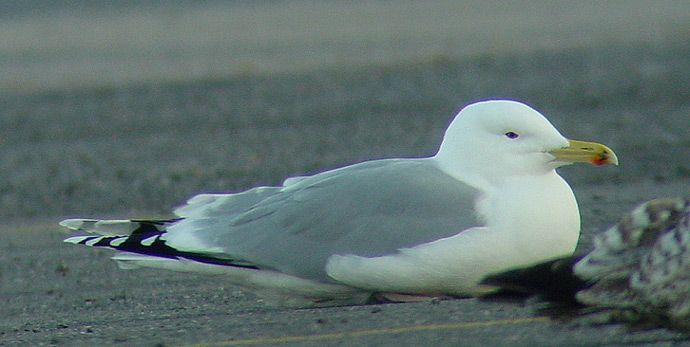 Herring
Gull - Zilvermeeuw (argentatus & argenteus)
Herring
Gull - Zilvermeeuw (argentatus & argenteus)
(last update: 08 december 2003)
Home
Links
to Gull Sites
Gull Taxa
Gull Topography
Grey & Colour Charts
Locations in NW Europe
Summaries of Articles
About ORG
@
Herring Gull adult (argentatus), January 04 2002, Le Portel / Boulogne-sur-Mer, France (50.42N,1.34E).
As described below, the difference
between typical western argenteus from the U.K. and northern
Scandinavian argentatus is rather straightforward on primary
pattern P5-P10. However, there is a gradient and overlap in features of
birds from populations in northern Germany, Denmark and southern
Norway.
Identification is even more challenging in birds from Baltic populations,
which show both characteristics of argenteus and argentatus,
but sometimes also of the southern taxa michahellis and
particularly cachinnans. An example of such Baltic argentatus,
superficially resembling cachinnans can be found in this picture.
Adult birds from the western populations argenteus
show more black in the outer primaries, compared to northern argentatus.
In argenteus, P5 normally shows
small black sub-terminal markings, concentrated on the
outer-web as a clear-cut black angular spot and in some birds extending on
the inner-web as a diffuse streak. There may be some black on P4 as well,
although this might be a clue for near-adult birds. In argentatus, especially from
far northern Scandinavia, the black
marking on P5
is completely lacking or is very limited and diffuse.
Argenteus often has a black sub-terminal band on the top of P10, dividing the tip from the mirror. If
the black sub-terminal band on P10 is broken, there is often still black
on the inner and outer-web's edge of P10. Normally argentatus lacks sub-terminal
markings on the outer-web of P10.
In adult Herring Gull, the scapular coverts are plain grey, lacking white crescents. The tertials
show obvious white tips. The iris is yellow. The bill is yellow with a red
gonydeal spot, confined to the lower mandible. The orbital ring is
yellowish or yellow-orange in argenteus; slightly orange-red or
coral red in most argentatus; especially birds from the Baltic region
show a bias to reddish orbital rings. The legs are flesh-pink in argenteus, but
may show a yellowish hue or appear very clear yellow in some argentatus
(from either the Baltic region or far northern Finnmark). Furthermore,
adult argentatus from Finnmark also seem to develop
"bubble-gum" pink legs.

The individual on the picture has the black marking on P5 confined to the outer-web as a single rectangular small black square, with well-defined borders (not diffuse as in most Finnmark birds), not unlike the pattern found in adult Baltic yellow-legged argentatus from the southern East Sea region and which winter in large numbers in north-east Netherlands and along the North Sea coast. The white tip of P10 fully merges with the mirror, without a single sign of a sub-terminal band and the white 'tongue' on the inner-web is broad, almost creating a thayeri pattern on P10. Note the shape of the division line between white tongue and black-sub-terminal band: rather angular, the line reaching the feather edge under an angle; the top not rounded but sharply defined by a straight line. Legs are pale yellow, the orbital ring is intense coral red and the bill is warm yellow with an orange-red gonydeal spot. The bill shows small black markings on both upper and lower mandible. The head, neck and breast are completely snow-white without any streaking, which is not uncommon by January and may be seen already by mid-December. All these features fit the East Sea argentatus Herring Gulls very well. In direct comparison with 4cy Yellow-legged Gull (L. michahellis), it proved to be obvious paler grey, but still darker than surrounding argenteus Herring Gulls.
It's pretty hard to pin down the exact geographical origins of this individual, but most features advocate Eastern Poland or a population elsewhere in the Baltic region and it may therefore be a yellow-legged representative of the nominate race argentatus. In some respects it resembles Pontic Gull L. cachinnans, but note the head profile (lacking the slender, long bill and long neck) and especially the P5 pattern, which normally shows a full sub-terminal black band on P5 in cachinnans. In cachinnans this P5 sub-terminal band is broad on both outer and inner-web, contra many argentatus, with a smaller band on the inner-web. However, some cachinnans may show less black on P5. Note also the pattern of the line dividing the grey centre of P10 from the black outer-web. In cachinnans this division line often makes a strong curve and has a smooth straight line, unlike the pattern of Herring Gulls, which often show a "saw-blade" motive or otherwise much irregularities along the division line. Sometimes wear of the outer primaries may be useful as a first indication of origin: note the rather fresh, broad white tips in the picture. An early moulting species as cachinnans would on average show more abrasion in the feathers. The only characteristic difficult to match with argentatus may be the pigmentation (though limited) in the iris.